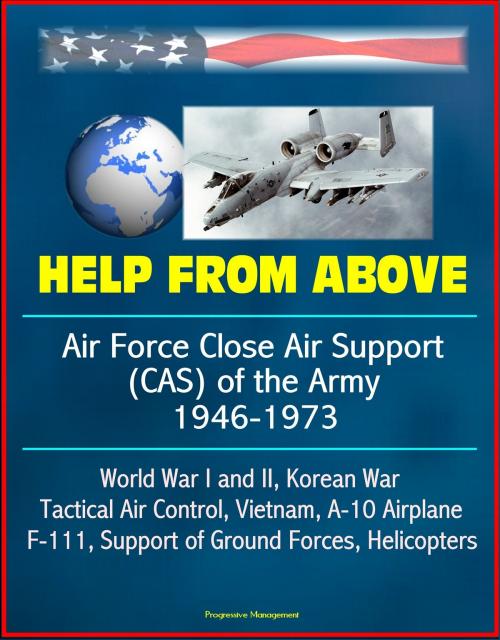Help From Above: Air Force Close Air Support (CAS) of the Army 1946-1973, World War I and II, Korean War, Tactical Air Control, Vietnam, A-10 Airplane, F-111, Support of Ground Forces, Helicopters
Nonfiction, History, Military, Aviation, World War II| Author: | Progressive Management | ISBN: | 9781310424779 |
| Publisher: | Progressive Management | Publication: | July 26, 2015 |
| Imprint: | Smashwords Edition | Language: | English |
| Author: | Progressive Management |
| ISBN: | 9781310424779 |
| Publisher: | Progressive Management |
| Publication: | July 26, 2015 |
| Imprint: | Smashwords Edition |
| Language: | English |
Professionally converted for accurate flowing-text e-book format reproduction, this Air Force publication examines the history of close air support. The issue of close air support by the United States Air Force in support of, primarily, the United States Army has been fractious for years. Air commanders have clashed continually with ground leaders over the proper use of aircraft in the support of ground operations. This is perhaps not surprising given the very different outlooks of the two services on what constitutes proper air support. Often this has turned into a competition between the two services for resources to execute and control close air support operations.
Although such differences extend well back to the initial use of the airplane as a military weapon, in this book the author looks at the period 1946-1973, a period in which technological advances in the form of jet aircraft, weapons, communications, and other electronic equipment played significant roles. Doctrine, too, evolved and this very important subject is discussed in detail. Close air support remains a critical mission today and the lessons of yesterday should not be ignored. This book makes a notable contribution in seeing that it is not ignored.
Chapter 1 - The Birth of Close Air Support * World War I * Between the Wars * World War II * Chapter 2 - Close Air Support Enfeebled 1945-1950 * On the Road to Independence * Independence * Reduction of Tactical Air Command * Congress and Close Air Support * Further Attempts to Improve Air-Ground Operations * Chapter 3 - Close Air Support in Korea * The War in Outline * The Close Air Support System in Korea * The Demand Side: The Air-Ground Operations System * The Supply Side: The Tactical Air Control System * The Joint Operations Center * Tactical Air Control Parties * Mosquitoes * Aircraft Issues * The Bottom Line: Command and Control * Chapter 4 - Close Air Support Under the New Look * The Services, The New Look, and Close Air Support * Further Attempts to Create Joint Air-Ground Doctrine * The Close Air Support Challenge from Organic Army Aviation * Chapter 5 - Close Air Support and Flexible Response: 1960-1965 * Early Stirrings of a Close Air Support Revival, 1961-1963 * The Army Proposes Its Own Airmobile Force: The Howze Board * The Air Force Defends the Existing System: The Disosway Board * A Joint Examination of Close Air Support * Field Testing the Opposing Close Air Support Concepts * Chapter 6 - The Vietnam Era: 1965-1973 * Air Force Close Air Support Validated in Vietnam * Armed Helicopters Also Legitimized * Toward a Specialized Close Air Support Plane * Chapter 7 - Conclusions * Notes * Glossary
The size of the close air support zone has also occasionally become a source of dispute as steady advances in military technology have gradually expanded the range of artillery and with it the battle zone. Most differences of opinion, however, centered on the means of conducting close air support. In this regard, controversy has accompanied such issues as the best type of aircraft for close air support (high- or low-performance planes, fixed-wing or rotary vehicles, single-purpose or multipurpose aircraft, or planes stressing survivability or responsiveness), the most effective types and combinations of ordnance, whether those controlling the planes during actual strikes should be airborne or located on the ground, and how best to operate at night and during periods of foul weather.
Professionally converted for accurate flowing-text e-book format reproduction, this Air Force publication examines the history of close air support. The issue of close air support by the United States Air Force in support of, primarily, the United States Army has been fractious for years. Air commanders have clashed continually with ground leaders over the proper use of aircraft in the support of ground operations. This is perhaps not surprising given the very different outlooks of the two services on what constitutes proper air support. Often this has turned into a competition between the two services for resources to execute and control close air support operations.
Although such differences extend well back to the initial use of the airplane as a military weapon, in this book the author looks at the period 1946-1973, a period in which technological advances in the form of jet aircraft, weapons, communications, and other electronic equipment played significant roles. Doctrine, too, evolved and this very important subject is discussed in detail. Close air support remains a critical mission today and the lessons of yesterday should not be ignored. This book makes a notable contribution in seeing that it is not ignored.
Chapter 1 - The Birth of Close Air Support * World War I * Between the Wars * World War II * Chapter 2 - Close Air Support Enfeebled 1945-1950 * On the Road to Independence * Independence * Reduction of Tactical Air Command * Congress and Close Air Support * Further Attempts to Improve Air-Ground Operations * Chapter 3 - Close Air Support in Korea * The War in Outline * The Close Air Support System in Korea * The Demand Side: The Air-Ground Operations System * The Supply Side: The Tactical Air Control System * The Joint Operations Center * Tactical Air Control Parties * Mosquitoes * Aircraft Issues * The Bottom Line: Command and Control * Chapter 4 - Close Air Support Under the New Look * The Services, The New Look, and Close Air Support * Further Attempts to Create Joint Air-Ground Doctrine * The Close Air Support Challenge from Organic Army Aviation * Chapter 5 - Close Air Support and Flexible Response: 1960-1965 * Early Stirrings of a Close Air Support Revival, 1961-1963 * The Army Proposes Its Own Airmobile Force: The Howze Board * The Air Force Defends the Existing System: The Disosway Board * A Joint Examination of Close Air Support * Field Testing the Opposing Close Air Support Concepts * Chapter 6 - The Vietnam Era: 1965-1973 * Air Force Close Air Support Validated in Vietnam * Armed Helicopters Also Legitimized * Toward a Specialized Close Air Support Plane * Chapter 7 - Conclusions * Notes * Glossary
The size of the close air support zone has also occasionally become a source of dispute as steady advances in military technology have gradually expanded the range of artillery and with it the battle zone. Most differences of opinion, however, centered on the means of conducting close air support. In this regard, controversy has accompanied such issues as the best type of aircraft for close air support (high- or low-performance planes, fixed-wing or rotary vehicles, single-purpose or multipurpose aircraft, or planes stressing survivability or responsiveness), the most effective types and combinations of ordnance, whether those controlling the planes during actual strikes should be airborne or located on the ground, and how best to operate at night and during periods of foul weather.















